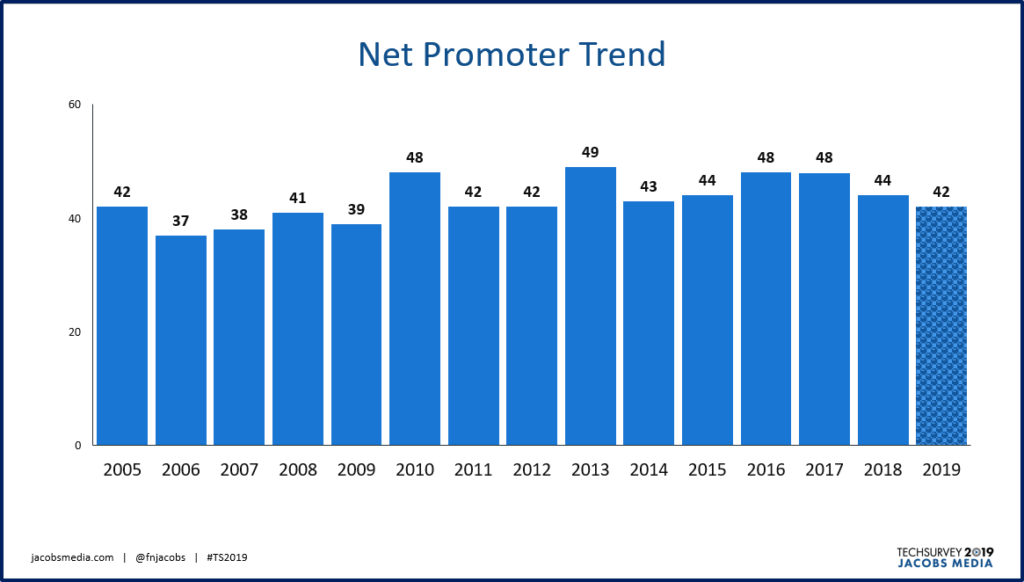
If you’re traveling this summer, chances are you’ll receive a survey from your hotel or car rental agency asking about their performance. And at some point in the questionnaire, they will likely ask the typical Net Promoter Score question:
“On a scale of 0-10 where ’10’ means very likely and ‘0’ means not likely at all, how likely is it you would recommend ____________________ to a friend, family member, or colleague?”
The scale – developed by Bain & Company in 2003 – quickly became the industry standard to measure a brand’s ability to generate positive word of mouth. Now, all the “big boys” – from Starbucks to Costco – use Net Promoter to measure their recommendation power.
By definition, NPS is a tough bar for brands. That’s because you’re not considered a true brand promoter unless you respond with a “9” or “10” to the question.

In a story in The Drum by Samuel Scott, the validity of NPS is debated by several marketers. And Scott asks the question: “Is NPS truly ‘the growth marketer’s secret weapon’ or more ‘snake oil and fake science?'”
That’s a question I get asked all the time. That’s because in 2005, we started including NPS in all our Techsurveys – for commercial, public, and Christian radio. And as a result, we generate scores for hundreds and hundreds of individual stations that participate in our survey.
Taken longitudinally – over time – NPS can tell an important story about radio brands, and their ability to motivate their audiences to recommend them. Here’s the tracking score for commercial radio, going all the way back to the beginning:

As stakeholder stations have come and gone since the survey was first launched, radio’s NPS level has remained in a narrow range – a low point of 37 in 2006 and the pinnacle in 2013 at 49. Across the 15-year span of Techsurvey, the average NPS has been 43 – close to this year’s score.
But where this data gets interesting is when we check it by format and radio platform – and of course, by individual station performance.
That’s where the learning gets interesting. Over the years, we’ve learned that formats and stations that lean female tend to have better NPS levels. I’ve noticed this in non-radio research, too. Women are simply more apt to recommend – and that’s important.
Similarly, spoken word formats – News/Talk, especially – don’t tend to perform as well. Their core audiences are far stingier when it comes to singing their praises to others.

And then there’s the obvious NPS “truth” when we compare the various radio platforms. Christian radio is off the charts, with an stratospheric 81, while public radio also bests every commercial format with an NPS of 70.
That speaks to the different relationships they foster with their audiences. Remember, their business models are a far cry from how a Sports or AC station turns profits. By and large, they are dependent on audience contributions – like Netflix but on the “honors system” – having to appeal to their cumes to pay for their content.
Perhaps that makes them more attuned to audience service. It also helps that they aren’t playing 10-12 minutes of produced ads every hour.
When stations look at their NPS data from year to year, fluctuations both up or down, generally are trackable to specific actions – firing the morning show, changing the music, etc. In a dynamic industry like radio, this metric is a great way to track changes in one of the most important dimensions – recommendation.
At a time when most radio stations are doing very little to market themselves, word of mouth – combined with the power of social media – can be a big driver. In past blog posts, we’ve talked about identifying “brand advocates” – fans who love you so much they want to become part of your team. NPS is one of the ways in which we identify these zealots.
As many marketers preach, getting a strong recommendation from a trusted friend, family member, or co-worker has infinitely more value than seeing an ad for the same product. Many people now won’t try a restaurant, by a vacuum cleaner, or drive a car unless it satisfies their review process. NPS goes to the heart of identifying the degree to which brands score well in a recommendation engine.
As some of the marketers in The Drum article point out, NPS in a vacuum can be an ineffective and even a misleading tool. It almost always requires additional research to determine precisely which factors are driving recommendations OR driving listeners away.
And by their very nature, some consumers are simply tough graders. For them, nothing earns a “9” or “10” score, and some simply don’t like giving  advice – good, bad, or otherwise.
advice – good, bad, or otherwise.
Strategists sometimes dismiss NPS for that very reason, but that’s denial, pure and simple. The same folks who don’t give anything the highest scores aren’t going to recommend your station anyway. It’s helpful to know who they are, their size, and their demography.
In the case of radio, some formats and specific stations have tremendous potential to benefit knowing where they stand on the NPS scale. It gives them the ability to marshal their fans both socially and in brand advocate initiatives where listeners can become station evangelists.
But even for mid-pack stations, knowing your NPR is an important piece of the puzzle. That’s because it’s a great barometer of fan passion. Stations that have it going can “feel” it when their audience is telling their story. NPS does a great job of tracking and confirming who they are and how to connect with them.
And when you see your NPS scores go sideways or even under water, there are usually good reasons that may or may not show up in perceptual research, and certainly not in the ratings.
Marketers often eschew NPS because it can be downright scary and event unpredictable. But for radio, in particular – a medium that thrives or dies on audience passion – it is a great way to find out where you stand on one of the most important measures:
The passion factor of your audience.
Radio has lived in a P1 world for so long now, programmers actually believe those numbers are a true reflection of loyalty and popularity. But they are anything but. They simply identify people who spend more time listening to your station, as opposed to the rest of the pack. But you can be a P1 and only listen to that station for a short period of time each week. And many P1s shift their loyalty about as often as they change socks.
The NPS “promoters” – the 9s and 10s – are gold. They’re the people who would follow a morning show over the Twitch. They’ll shell out cash at your festival. They’ll download your station app and take you wherever they go. They’ll buy your merch and wear it proudly.
NPS may be the best and simplest way to measure your brand’s health.
Back in the 80s, the colorful mayor of New York City, Ed Koch, had a well known catch-phrase:
“How’m I doin’?” 
He asked it of everyone – reporters, cops, and of course, his constituents – the people he called his “publics.”
Koch wasn’t just folksy and charming – he truly wanted to hear feedback on his – and New York City’s – performance.
In many ways, he was ahead of his time. Now we rate everything – on Amazon, Yelp!, Netflix, Trip Advisor, and any number of online forums and recommendation sites.
Net Promoter Scores are a great way to truly discover your brand worth.
So how’s your NPS?
- Radio, Now What? - April 14, 2025
- The Hazards Of Duke - April 11, 2025
- Simply Unpredictable - April 10, 2025




Leave a Reply